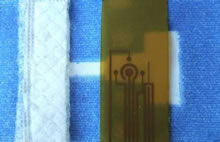Smart clothing with fluid biosensors to monitor health
31 March 2008
The European BIOTEX project has produced textiles with woven-in miniaturised biosensors that can analyse body fluids such as sweat to assess the wearer's state of health.
The project is being co-ordinated by the Swiss Centre for Electronics and Microtechnology (CSEM) and involves universities and small enterprises from Italy, France and Ireland.
Jean Luprano, a researcher at CSEM said: “One of the most obvious applications for smart fabrics is in the medical field. There has been a good deal of progress with physiological measurements, body temperature or electro-cardiograms. But no-one has yet developed biochemical sensing techniques that can take measurements from fluids like sweat and blood.
"We are developing a suite of sensors that can be integrated into a textile patch. The patch is a sensing and processing unit, adaptable to target different body fluids and biochemical species. At the very least, some basic biochemical analyses could complement the physiological measurements that can already be monitored. In some circumstances, fluidic analysis may be the only way to get information on a patient's health status.”
Sensing success
One of the main achievements of the project has been the development of a suite of prototype ionic biosensors, capable of measuring sodium, potassium and chloride in sweat samples. Another probe measures the conductivity of sweat and a miniaturised pH sensor uses colour changes to indicate the pH of sweat. An immunosensor, which could be integrated into wound dressings or bandages, can detect the presence of specific proteins in fluid samples.
These biosensors are not just scaled-down versions of existing technology, Luprano is keen to point out: “Many of the chemical or biochemical reactions used in sample assays are non-reversible and some part of the biosensor has to be replaced. When you monitor continuously you can't do that; you need a sensor that binds your substrate reversibly. Also, the BIOTEX sensors work on tiny volumes of liquid, so we had to come up with innovative designs and materials that would make it possible to miniaturise the sensors and make them compatible with fabrics.”
 |
|
A prototype sensor for measuring electrolyte concentration in sweat |
Several of the BIOTEX probes, including the pH sensor, use colour changes or other optical measurements. For example, as sweat passes through the pH sensor it causes an indicator to change colour which is detected by a portable spectrometer device. The immunosensor technology works in a similar fashion. Plastic optical fibres (POFs) are woven into the fabric so that light can be supplied to the optical sensors and the reflected light directed to the spectrometer. Small and smart
The BIOTEX oxygen probe measures levels of oxygen saturation in the blood around the thorax using a technique called reflective oximetry. A cluster of POFs allows a large surface of the thorax to be illuminated and improves the collection of the reflected red and infrared light used for the oximeter sensor. Signal processing also improves the sensitivity of this method.
The project overcame the problem of getting the tiny amounts of body fluids excreted from the skin into the biosensors. “The volume of fluid secreted from sweat glands is just a few millilitres over a small surface,” says Luprano, “and the body's heat means this is rapidly vaporised. We needed some kind of pump that could collect sweat in one area and bring it to the sensor array, where it could be channelled through each sensor.”
The solution uses a combination of hydrophilic (water-loving) and hydrophobic (water-repellent) yarns. It is possible to weave these two threads to direct the sweat through fabric channels to the sensor array. It is a passive system using no power, thereby reducing the power demands of the BIOTEX system (and the weight of a battery pack that the wearer would have to carry).
In the first BIOTEX trials, the smart patches will be worn in clothes by people with obesity and diabetes, as well as athletes. Once the technology has been validated, the plan is to take on industrial backers to commercialise it. Meanwhile, a large EU-funded project within the same SFIT group, called PROETEX, is integrating the technology with other micro- and nanosystems for specific applications (fire fighting and rescue teams).
Whilst BIOTEX has solved several of the technical aspects of continuous biochemical monitoring, Luprano calls for more research into the application of this technology.
“It's new and healthcare providers are not used to it. We are not used to the information that continuous, remote monitoring can provide — so different to the one-off laboratory tests that are usually taken. BIOTEX makes this remote monitoring possible, but more research into the links between these indicators and disease conditions and states will make it realistic. Nevertheless, in the long-term we expect continuous monitoring, made possible with smart textiles, to make a major improvement to the way we approach the treatment of metabolic disorders and leisure.”
Further information
BIOTEX project members
- Centre Suisse d´Electronique et de Microtechnique SA (CSEM), Switzerland
- Commissariat à l'Energie Atomique (CEA), France
- Smartex s.r.l. (SMARTEX), Italy
- University of Pisa (UP), Italy
- Thuasne, France
- Penelope SpA, France
- Sofileta, France
- Dublin City University (DCU) Ireland
Project website: www.biotex-eu.com/html/partners.html
Project results available as PDF files (download from the project website)
- New generation of smart sensors for biochemical and bioelectrical applications: download file
- A new route through wearable interfaces for healthcare: download file
- Biosensing textile to support healthcare: download file
- Towards the measurement of sweat rate via wearable sensors: download file
- Wearable biosensors to support wound healing: download file
Source: ICT Results
http://cordis.europa.eu/ictresults/index.cfm/section/news/tpl/article/id/89605